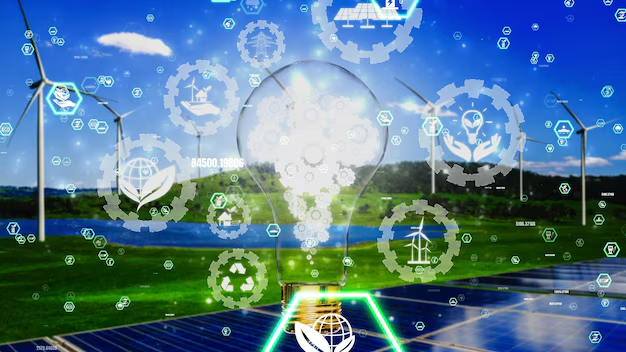Nanotechnology, the science of manipulating materials at the atomic or molecular scale, has emerged as a powerful tool for advancing various fields, including renewable energy. By enhancing the properties and efficiency of materials used in energy generation, storage, and conversion, nanotechnology holds the potential to revolutionize the renewable energy sector. In particular, it can help optimize solar, wind, and other renewable energy technologies to make them more efficient, cost-effective, and scalable. Here are some key ways nanotechnology is improving renewable energy sources.
1. Enhancing Solar Energy Efficiency
Solar energy is one of the most widely adopted renewable energy sources, but the efficiency of solar panels has been limited by the materials used in their construction. Nanotechnology offers the ability to improve solar cells in several ways:
- Nanomaterials for Better Absorption: Nanomaterials, such as quantum dots, nanowires, and nanostructured films, can be used to enhance the absorption of sunlight. These materials have unique optical properties that allow them to capture a broader range of the solar spectrum, increasing the efficiency of solar cells.
- Thin-Film Solar Cells: Nanotechnology is also being used to develop thinner, lightweight solar panels that can be applied to various surfaces, from rooftops to clothing and vehicles. These thin-film solar cells, made with nanomaterials, are more cost-effective and flexible than traditional silicon-based panels.
- Increased Conductivity: Nanomaterials can improve the electrical conductivity of solar cells, which leads to higher efficiency in converting sunlight into electricity. Materials like carbon nanotubes and graphene are often used to enhance the performance of solar cells by reducing energy loss and increasing charge transport.
2. Improving Wind Energy Efficiency
Wind energy is another crucial renewable resource, but it faces challenges such as the durability and efficiency of wind turbines. Nanotechnology can help improve the efficiency and longevity of wind energy systems:
- Stronger and Lighter Materials for Turbine Blades: Nanotechnology can be used to develop stronger, lighter composite materials for wind turbine blades. These materials are more resistant to wear and tear, reducing maintenance costs and extending the lifespan of turbines.
- Nanocoatings for Durability: Nanocoatings can be applied to wind turbine blades to reduce friction and prevent the buildup of ice and dirt, which can impair turbine performance. These coatings help maintain the blades’ efficiency over time, especially in harsh weather conditions.
- Enhanced Power Conversion: Nanomaterials can also improve the performance of the electrical components of wind turbines. For instance, nanostructured magnets and superconducting materials can be used in generators and power converters, improving energy output and reducing energy losses.
3. Advancing Energy Storage Solutions
Renewable energy sources such as solar and wind are intermittent, meaning they are not available all the time. Efficient energy storage is essential to ensure a stable and reliable power supply. Nanotechnology can play a significant role in enhancing energy storage systems:
- Nanomaterials in Batteries: Nanotechnology is being used to develop advanced battery technologies, such as lithium-ion and solid-state batteries, with higher energy density and longer lifespan. Nanomaterials like graphene and carbon nanotubes are being incorporated into batteries to increase charge storage capacity, improve battery life, and reduce charging times.
- Supercapacitors: Nanotechnology can also enhance supercapacitors, which store energy more efficiently than traditional batteries. These devices use nanomaterials to store and release energy quickly, making them ideal for use in conjunction with renewable energy sources. Supercapacitors can help smooth out fluctuations in energy supply, ensuring a steady flow of power.
- Hydrogen Storage: Nanotechnology can also improve the storage and transport of hydrogen, a clean energy carrier. By creating nanostructured materials that absorb and release hydrogen more efficiently, nanotechnology can make hydrogen storage safer and more cost-effective, facilitating its use as a renewable energy source.
4. Enhancing Bioenergy Production

Bioenergy, including biofuels and biogas, offers another renewable energy source, but the production of these fuels has been limited by the efficiency of the processes involved. Nanotechnology can improve bioenergy production in several ways:
- Nanocatalysts for Biofuel Production: Nanocatalysts can increase the efficiency of biofuel production processes by speeding up chemical reactions and improving the conversion of biomass into fuels. These nanomaterials are highly active and can be tailored to specific reactions, leading to more efficient and cost-effective biofuel production.
- Improved Bioreactors: Nanotechnology can improve bioreactors, which are used in the production of biogas and other biofuels. Nanomaterials can enhance the efficiency of microorganisms that convert organic waste into energy, making the process faster and more productive.
- Enhanced Biomass Conversion: Nanomaterials can also be used to improve the conversion of agricultural waste and other biomass into renewable energy. By breaking down biomass more efficiently at the molecular level, nanotechnology can make bioenergy production more sustainable and economically viable.
5. Contributing to Energy Efficiency in Buildings
Nanotechnology can improve the energy efficiency of buildings by optimizing heating, cooling, and insulation systems. Nanomaterials can be used to create energy-efficient coatings and insulating materials, helping buildings retain heat in the winter and remain cool in the summer. This reduces the need for artificial heating and cooling, lowering energy consumption and promoting sustainability.
- Nanocoatings for Solar Energy Harvesting: Nanotechnology can also help develop coatings that capture solar energy for heating purposes. These coatings, applied to windows and other building surfaces, can absorb and convert sunlight into thermal energy, reducing the need for external power sources.
- Smart Windows: Nanotechnology is being used to develop smart windows that can adjust their opacity based on temperature and sunlight. These windows can help maintain comfortable indoor temperatures without relying on air conditioning or heating systems, thus improving energy efficiency.
6. Environmental Benefits
Nanotechnology can enhance the environmental sustainability of renewable energy sources. By improving the efficiency and reducing the costs of renewable technologies, nanotechnology helps reduce reliance on fossil fuels and lower greenhouse gas emissions. Furthermore, nanomaterials are often more sustainable and have a lower environmental impact compared to conventional materials.
For instance, nanomaterials used in solar cells and batteries are often more abundant, require less energy to produce, and can be recycled more easily, leading to a reduction in environmental waste.
Conclusion
Nanotechnology has the potential to significantly enhance the efficiency, scalability, and sustainability of renewable energy sources. By improving the performance of solar panels, wind turbines, energy storage systems, and bioenergy production, nanotechnology is helping to accelerate the transition to a clean, renewable energy future. As research and development in nanotechnology continue to progress, its role in renewable energy is expected to grow, driving innovation and reducing the environmental impact of energy production.
FAQs
1. How does nanotechnology improve solar panels?
Nanotechnology improves solar panels by enhancing their light absorption, conductivity, and efficiency through the use of nanomaterials like quantum dots and nanowires, allowing for higher energy conversion rates.
2. What role does nanotechnology play in wind energy?
Nanotechnology helps improve the strength, durability, and efficiency of wind turbine blades by using lightweight, strong composite materials, as well as applying nanocoatings to reduce wear and maintenance.
3. Can nanotechnology make energy storage more efficient?
Yes, nanotechnology enhances energy storage by improving battery capacity, reducing charging times, and making batteries and supercapacitors more durable. Nanomaterials like graphene are key in improving energy density and lifespan.
4. How does nanotechnology contribute to bioenergy production?
Nanotechnology accelerates biofuel production by improving the efficiency of catalysts and bioreactors, enhancing biomass conversion, and making bioenergy production processes more sustainable and cost-effective.
5. Is nanotechnology environmentally friendly in renewable energy applications?
Yes, nanotechnology can make renewable energy technologies more sustainable by reducing material waste, improving efficiency, and lowering the environmental impact of production processes.


